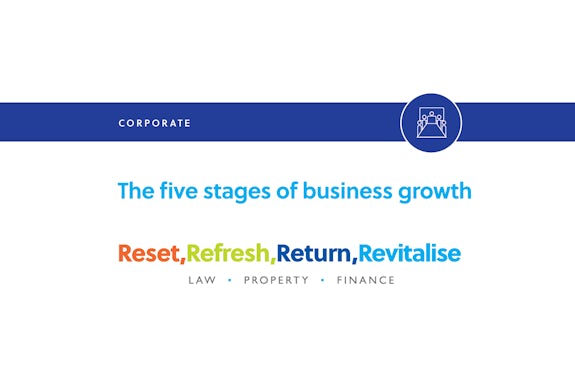
By David Winnie
May 20, 2025

No business starts big. Behind every multi-national, there is a history of smaller businesses growing and selling and acquiring. A business either gets bigger or it gets smaller. The shrinking business either reverses the trend or goes bust. The growing business expands to the point where it must sell or to acquire.
Over the last few decades, whole industries have grown up to mentor and support growth. Many of the approaches date back to research in the USA from the 70s and 80s. Acclaimed research by Harvard Business Review identified five stages of small business growth: Existence; Survival; Success; Take-Off; and Maturity.
In this series of articles we’ll look at the particular legal issues of each phase.
______________________________
Stage 1: Existence
This is the true start up phase. One or two entrepreneurs have a good idea and have taken the plunge. They have a shiny new company! It has just entered into existence. However, a business can fail, and fail quickly. Now that the owners have a Certificate of Incorporation, they face pressing questions…
Do we have enough money to cover costs?
Until sales kick in, everything is a cost. Time is the enemy. Cash flow has to be created before seed capital runs out. It might not seem that there are legal issues – there is no money for fees! – but think of the following:
– Is your client using share capital or directors’ loans? The former is harder to recover, as the rules on dividends and buyback of shares under the Companies Act kick in. Until there are distributable reserves, there may be no return. A loan is easier to get back – it is a loan to be repaid, after all – but it is also a debt. Lenders might want it deferred, in which case it might be sensible to convert it to equity.
– Consider redeemable shares as a compromise. These can carry a dividend and a vote. The key to redeemable shares is that the approval process for their purchase is built into the company’s articles. They have the benefit of being shares on the balance sheet, but also give a route to recovery.
How do we get customers? How do we provide services? How do we get paid enough to recoup costs?
Your client needs buyers, and needs them fast. They must tell everyone about the business: social media, word of mouth, networking meet ups, flyers can all play a part in getting the word out. Meet everyone they know. Call everyone they know. Coffee, coffee, coffee. But be careful:
– keep an eye on the cost and scope of work. Too often, customers can take advantage of a very new business by seeking unfair concessions or un-commercial pricing. Beware of selling at any price, just to get revenue – that is the road to a loss.
– keep a record of every commitment and promise. There are five key elements to a contract: WHO (get the full name of the other party); WHAT (record what is to be done); WHERE (say where it will be done, if there is to be a delivery); WHEN (say when you will deliver and get paid); and HOW MUCH (the price). There might not be money for terms of business just yet, but even a quick email or text setting this down will help if there is any argument.
And then…within a few weeks, comes a month end. The first bills go out. The first payment comes in. Now comes the point we cover in our next article: Stage 2 -Survival.
If you would like further information on the topic discussed in this article, please contact Derek Hamill by email: dhamill@gilsongray.co.uk or by phone: 0141 530 2022 / 07973 924 333. You can also view Derek’s profile by clicking here.
The information and opinions contained in this blog are for information only. They are not intended to constitute advice and should not be relied upon or considered as a replacement for advice. Before acting on any of the information contained in this blog, please seek specific advice from Gilson Gray.

Derek specialises in advising owner-managers in connection with finance, contracts and structural issues and has exceptional knowledge of international contract law.